
Landscape Photography: Capturing the Earth's Elegance
Share
The Art and Science of Landscape Photography
Landscape photography, more than just a passion or hobby for many, is a profound method of storytelling and environmental conservation. Capturing the elegance of the Earth through a lens involves not just technical skills, but an emotional connection to the environment. But what makes a landscape photograph stand out? How can photographers, both seasoned and amateurs, use their craft to highlight and preserve the beauty of our planet?
Understanding the Basics: What Makes a Good Landscape Photo?
At its core, landscape photography is about representing the natural and occasionally the human-shaped environment in a way that draws the viewer into a scene. This genre of photography goes beyond merely taking snapshots of beautiful views. It involves a blend of compositional elements, proper lighting, and an eye for detail. Here are key components required to elevate a landscape photograph:
- Composition: Successful landscape photography is heavily reliant on composition. The rule of thirds, leading lines, and the incorporation of natural features can guide the viewer’s eye through the image.
- Light: Understanding and making use of natural light is crucial. The golden and blue hours—shortly after sunrise or before sunset—provide soft, diffused light that enhances textures and colors in the landscape.
- Perspective: Sometimes, changing the perspective can dramatically alter the photo. Experimenting with high and low angles can add variety to your photographs and show the landscape from a unique viewpoint.
Technological Advancements in Landscape Photography
In the digital age, the field of landscape photography has seen significant technological advancements. High-resolution cameras, sophisticated drones, and post-processing software have all expanded the possibilities for capturing and enhancing images. These tools allow photographers to express their artistic vision in precise ways that were not possible before.
Today's technology allows us to capture landscapes in unprecedented detail, says Dr. Emma Brown, an award-winning landscape photographer. It empowers us not only in terms of aesthetic representation but also in our ability to document environmental changes.
The Role of Landscape Photography in Environmental Conservation
One of the most powerful aspects of landscape photography is its ability to raise awareness about environmental issues. Through stunning visuals, photographers have the opportunity to bring attention to the beauty of untouched landscapes as well as the devastating impacts of human activities.
Notable landscape photographer John O'Reilly mentioned, Each shot captured by my camera serves as a call to action. It’s a plea to viewers to recognize the worth of these pristine environments and the urgent need to protect them. This sentiment is becoming increasingly common among photographers who view their work as part of a larger environmental dialogue.
Practical Tips for Aspiring Landscape Photographers
- Learn continuously: Like any art form, constant learning and adaptation are key. Keep up with new techniques and advancements in camera technology.
- Understand the environment: Great landscape photos come from photographers who have a deep understanding of the geography and ecology of the areas they shoot in.
- Respect nature: While capturing nature’s beauty, it’s vital to respect the environment. Stick to paths and natural barriers, and leave no trace of your visit behind.
Conclusion: A Call to Action
Landscape photography is more than just a technique; it's a passionate engagement with the world that necessitates sensitivity, skill, and a sense of responsibility. As someone who captures the beauty of our planet, it's also your duty to protect it. Whether you are a hobbyist or a professional, consider using your photographs as a force for good—inspire others to love and conserve our natural landscapes. Let every shot not only capture the beauty of the Earth but also echo the importance of preserving such splendor.
If you're ready to start your journey in landscape photography, remember that every small step counts. Begin by exploring local landscapes, understand your gear, and connect with fellow enthusiasts. The world is full of beautiful scenes waiting for you to capture and protect. What are you waiting for?





